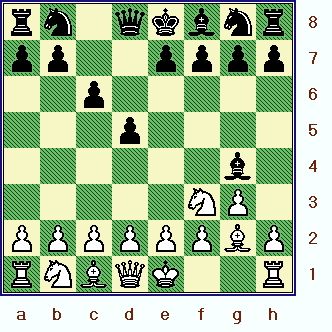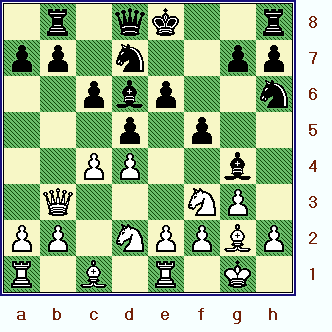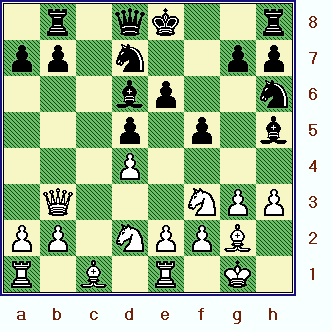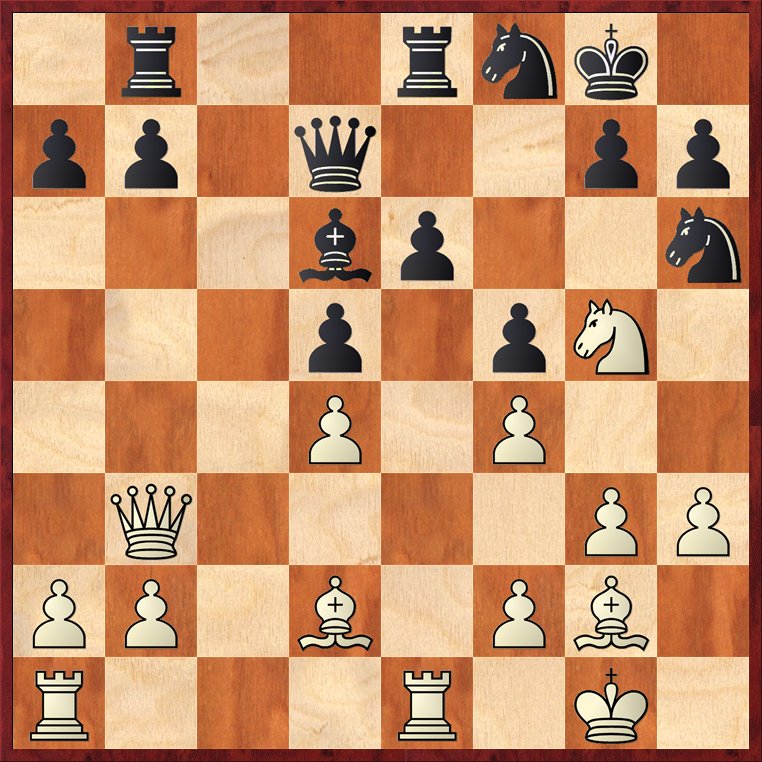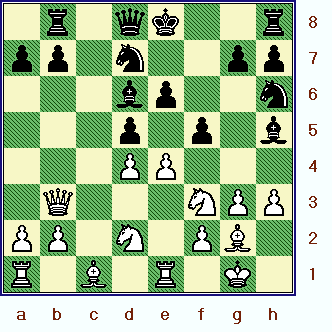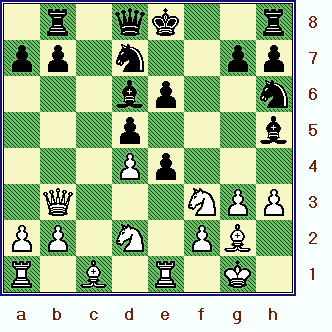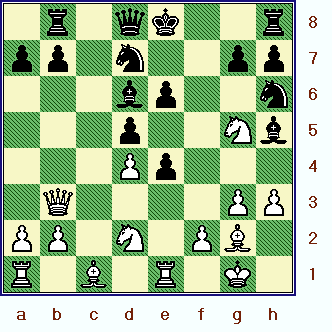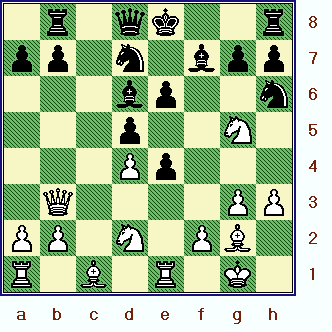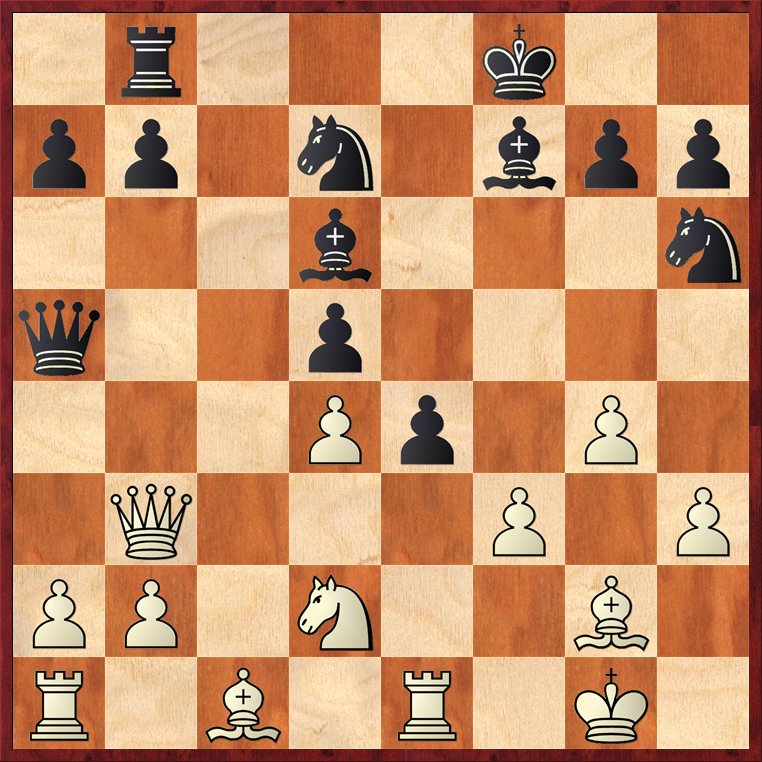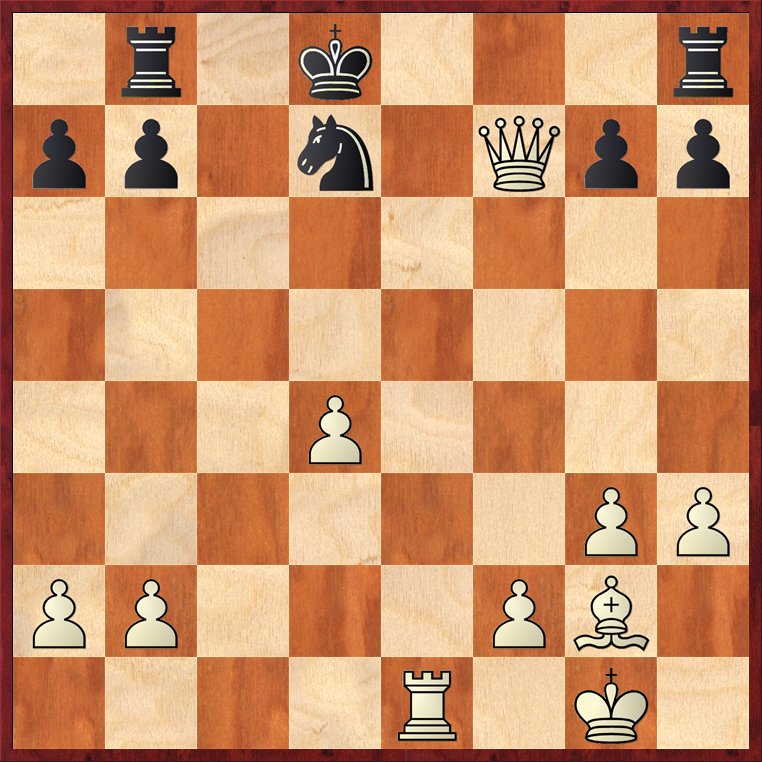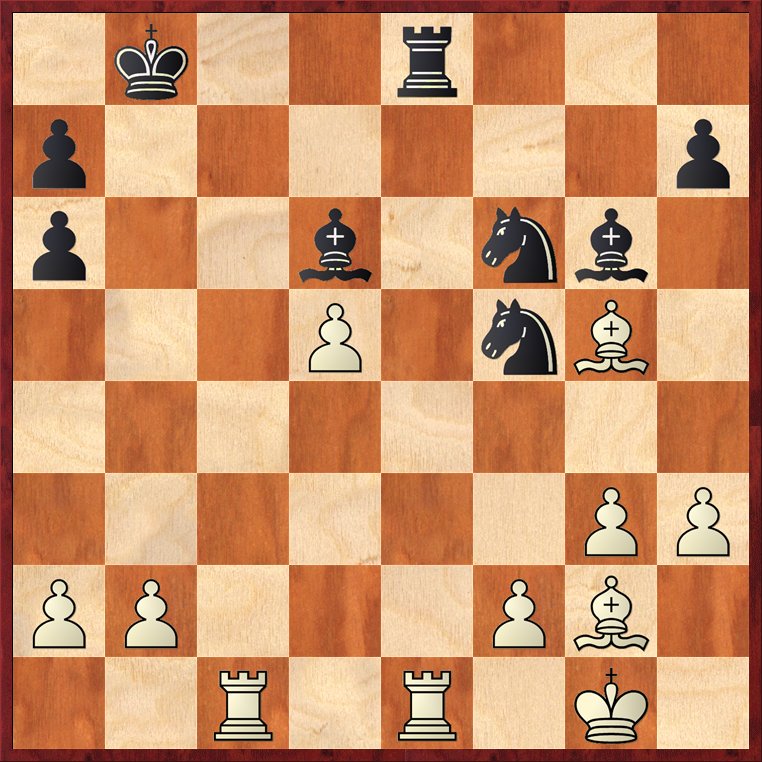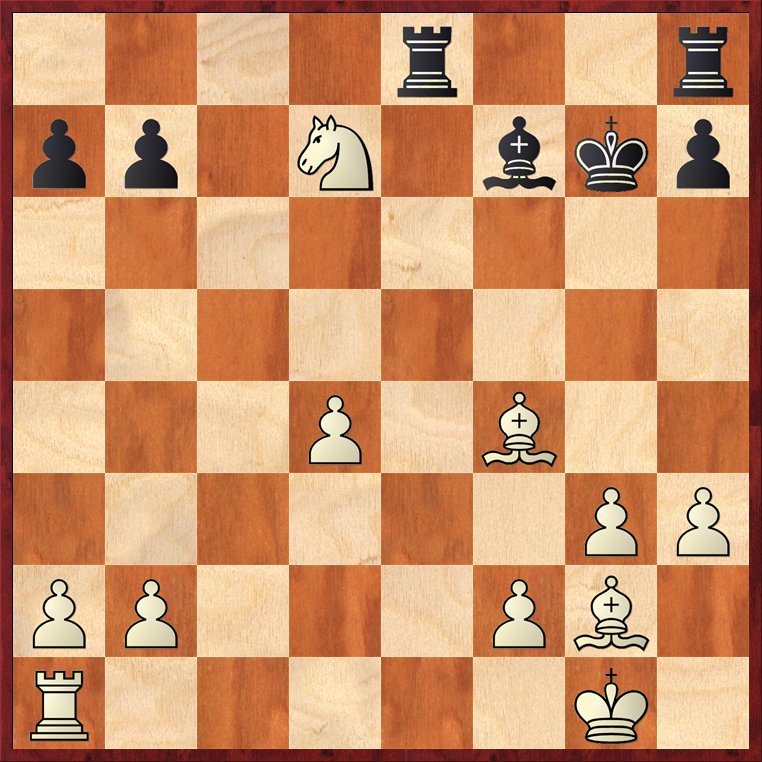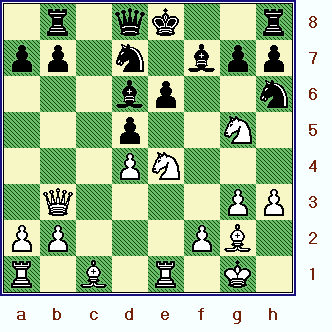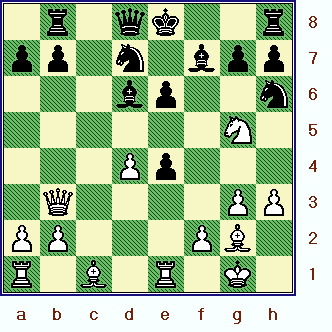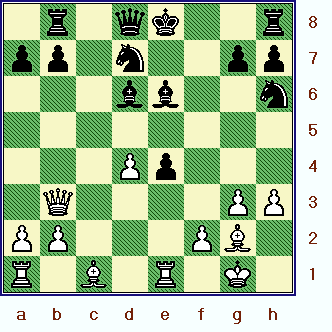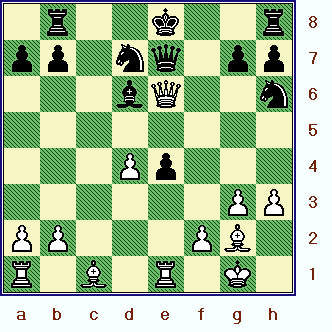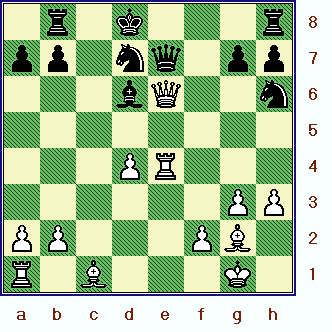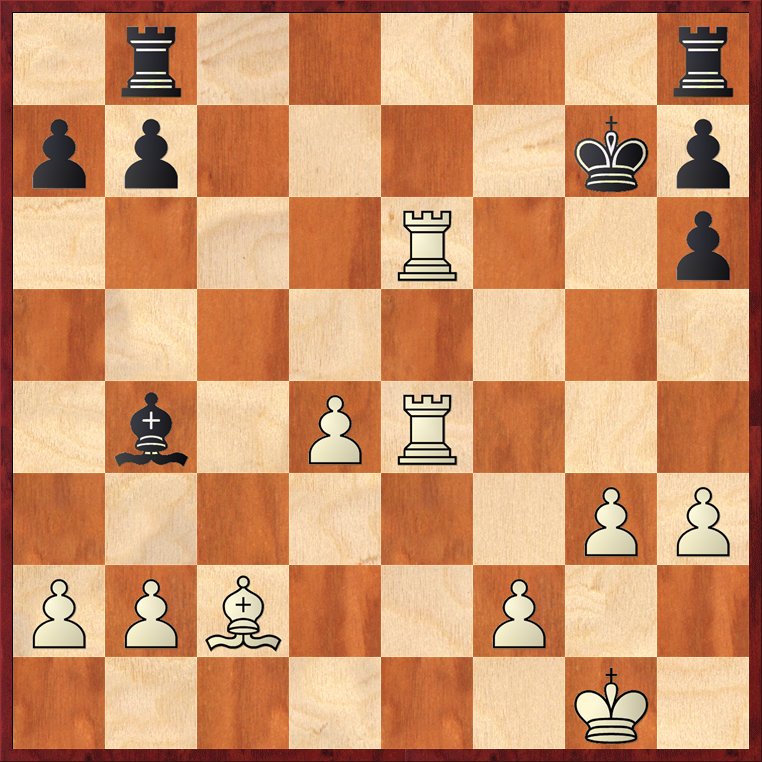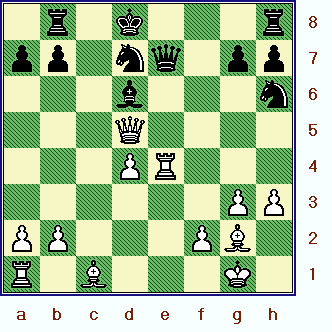All
the |
(Navigation bar
directly below.)
*******
© A.J. Goldsby, 2015.
(All rights reserved.)
****************
Click HERE
to see my
Chess Items.
****************
****************
Buy a book
from Amazon.com
(And help me out as well!)
****************
Click HERE
...
to see a list of the businesses that help to sponsor all of
my chess efforts.
Kramnik - Beliavsky, 1995.
("A Ten's ten.")
This was an extremely impressive game, I was virtually overwhelmed by the tactics - I tried to annotate this game (in depth), as it would make a good addition to my "School of Tactics" ... as well as my collection of Miniature games. (Of course, I will post it on my main page ... and my "Annotated Games" page as well.) This game was also a "Problem of The Day," on Saturday / April 30th, 2011. So my annotating this game continues my <recent> tradition of looking at games when the "Chess Games" website brings them to my attention. (I am user "LIFE Master AJ" on that particular website ... look for my comments on the game in the <kibitz> section, underneath the re-playable game itself.)
---> (Late Dec. 2011) I save most of the e-mails that I consider to be important ... I was going through a folder with this info, I was actually looking for something else -- right after my computer crashed. Anyway, I discovered an e-mail from a fan in August of 2008 ... he asked that I do a web page on this game. I forgot all about this request, I had procrastinated and basically put it off until another time. I think I may have begun annotating this game at that time ... because when this game was featured on the CG website, I found a version of this game that I had begun to work on ... but never finished. This version of annotation was poor, at least by my standards. ~~~ I deleted it, and basically started over.
I felt that it was absolutely essential for me to ... "get this game right." If not perfect, then it certainly had to come as close (to being perfect) as I could make it. I started on this game right after it was the POTD, (that evening); and I have worked many hours on it since. (A couple of times, I worked all night ... got the girls off to school ... and then continued to work for many hours ... until I "ran out of gas" and I had to lie down and take a nap.)
In
the book,
"My Life and Games," (page
# 127) the author(s) ... (V. Kramnik +
1, see the bibliography at the end of this game.) ...
... there classifies this game under the (main)
heading of "Breakthrough."
He goes on to give the (bold) sub-heading of: "With thanks to faulty equipment."
He
then writes:
<< "This was the last round, and for overall victory in the
tournament it was essential for me to win. For this reason, I avoided the main
theoretical set-ups of the Queen's Gambit, which were well known to my opponent,
and chose something of a sideline. Especially since at the start of the
tournament my computer had broken down, and all my opening preparation came to
nothing. I had to play "on spec", and I myself was surprised that with
such a modest opening I was able to win, within the "official bounds"
of a miniature game ..." >> (Vladimir Kramnik)
Now - you don't have to take my word for what the sources looked like ... or what lines they looked at ... you can see for yourself!
-
Page One (of this book).
-
Page Two (of this book).
-
View the Informant analysis - saved in 'ChessBase' form - and then saved as a "screen-capture."
Click HERE to see an explanation of the symbols that I commonly use when I annotate any chess game.
Click HERE to replay this game ... on another server.
Click HERE
to see my video channel on the "You-Tube" channel. [
Part
#01, of my video series on this game. Part # 02,
Part # 03. ]
(I now make a chess video for ALL the web pages that I am making for the
Internet.)
GM
Vladimir Kramnik (2730) - GM
Alexander G. Beliavsky (2650)
|
|
|
[A.J. Goldsby I]
This is a brilliancy of the highest order ... I cannot recall many games that intrigued me beyond any capacity that I might possess to properly describe it.
Kramnik relates that he played this
opening very modestly because his computer (laptop)
had broken down.
(See the section at the top of this page, and
please read it carefully. -- ye olde editor.)
****************************************************************************************************************************************************
****************************************************************************************************************************
****************************************************************************************************************************************************
Play starts off as a Reti -
which often transposes to many other opening lines.
(For good coverage of systems of the Reti Opening, please see MCO-15, beginning on page # 718.)
1.Nf3 d5; (center control; space)
This is one of the standard replies to 1.N/g1-f3, although it is far from being the only one! [Black could push either one of his Pawns ahead, (one ... or even two squares); or he could also develop a N as well.]
[ Also good for Black is: 1...Nf6;
which is (maybe) slightly more
flexible than any Pawn move.
(This - also - could transpose to an almost unlimited number
of different opening systems. ]
2.g3, (Fianchetto.)
Instead of a Reti, this leads to
variations more like those of the "King's Indian Attack / King's Indian Reversed / Barcza System."
[See the lines in MCO-15, beginning on page # 724.]
[ One of the "standard lines" (of the Reti Opening) is "The Lasker's Defense."
(Some books also refer to this as "The London System.")
This can be reached via the following move order:
2.c4
c6; 3.b3 Nf6; 4.g3 Bf5; 5.Bb2 h6;
6.Bg2 Nbd7; 7.d3 e6; etc.
[See MCO-15; page # 720; and column # 04. (Plus notes.)] ]
2...c6; 3.Bg2 Bg4; (Hmmm.)
Often times, ... in a closed opening ... an amateur will bring his light-squared Bishop out early.
|
|
rn1qkbnr/pp2pppp/2p5/3p4/6b1/5NP1/PPPPPPBP/RNBQK2R w KQkq - 0 4
And I would usually label it as possibly dangerous and premature.
However ... here ... Black is a very strong GM ... so you would think that he would know what he is doing.
Nonetheless ... I think that I would
still have to recommend, (at least to the average player); that Black should transpose to the 'normal'
variations of the Closed Catalan ... ... ... or try one of the lines given below.
[ The top choice of the new Fritz "Power Book" is:
RR
3...Qc7; 4.0-0 e5; 5.d3, "+/="
and while White might be a tiny bit better, Black has a nice, flexible and playable position.
**************************************************************************************************
A standard line would be:
>/= 3...Nd7;
4.0-0 e5; 5.d3, "+/=" and White has a tiny edge.
A good game would be:
GM Joerg Hickl (2600) - GM
Ralf Lau (2510) [B10]
Master's Open /
Vienna, AUS; (R#7) 1996.
{White won a nice game, 1-0 in around 55 moves.}
**************************************************************************************************
Black can transpose to a Closed Catalan Opening by playing:
RR
3...Nf6; 4.d4 e6; 5.0-0, (Development plus King safety.)
This is good ... it removes the WK from the center, and also prepares
to get the King's Rook into the fray.
(This is the first choice of the well-known, "Fritz Power-Book.")
( White could also play:
5.c4 Nbd7; 6.Qc2 Be7; 7.0-0, "+/=" 7...0-0; {etc.}
with a good
game for both sides here. )
5...Nbd7; 6.Nbd2 a5!?; 7.c3
Be7; 8.Qc2 0-0; 9.e4, "+/="
(with a small edge
for White);
and White is somewhat better here.
For more info on the <<book lines>> of the closed Catalan, please see:
MCO-14, page # 532; columns # 37 through # 42. (And all notes.)
]
4.0-0 Nd7; 5.d4 e6; 6.Nbd2 f5!?, (Hmmm.)
A doubtful concept?
Now perhaps Black goes too far ... he is ignoring his development and weakening a lot of squares ...
all for the sake of trying to prevent White from getting in e2-e4. (Note the huge hole on e5.)
Of course, GM A. Beliavsky has had some fair successes with the Dutch. One of the more famous opening systems, (of the last 50 or so years); is the system of the Dutch where Black places his pawns at c6, d5, e6, and f5. This P-skeleton is known as ...
"The Stonewall System." This is an opening that was virtually dead ...
and then many of the "young turks" in the 1980's and the 1990's began using this system ...
and scored some amazing victories with it.
(This led to a complete revival of this particular opening system.)
Here - GM Alexander Beliavsky tries his hand at a type of "Stonewall" pawn formation; yet I am not sure if this type of pawn structure is appropriate ... given White's very flexible opening set-up.
(If you have studied this particular GM games at all, you would know that he often takes some risk with Black
...
in an attempt to try and win the game.)
Another thing to consider ... is that this is all existing opening theory! (No kidding!!)
If you doubt this, then see the game: W.
Hug - J. Speelman; Altensteig, Germany / 1994.
(See Informant # 63, game # 320.)
<< "It should be said that at that time Black's last move was beginning to come into fashion." >>
- GM V. Kramnik, in his book, "My Life and
Games."
[ It would have been definitely better ... (and much safer) ...
for Black to have (instead) played the following continuation:
>/= 6...Ngf6;
7.Re1 Bf5; 8.c4, "+/=" (space, P-skeleton)
when White may have a small edge in this position ...
but it is nothing to write home about.
]
7.c4 Bd6; 8.Qb3 Rb8; 9.Re1 Nh6!?; (Why?!?)
You have heard it said ... over and over again ... "A Knight on the rim is grim, and his future is dim!"
|
|
1r1qk2r/pp1n2pp/2pbp2n/3p1p2/2PP2b1/1Q3NP1/PP1NPPBP/R1B1R1K1 w k - 0 10
So you have to ask yourself
why a strong GM like Beliavsky would play such a move!
(I think that part of the answer is that Beliavsky wants to cover the hole on e5 - sitting on h6,
the Knight could go to f7 ...
on the very next move.)
This move is very risky ...
and most probably bad, (I think it could be labeled as a dubious ['?!'] move here.) ...
... judging from the reaction of several different chess engines that I tested, when I was
analyzing this great game.
[ It was probably better for Black to have played:
>/=
9...Ngf6;
although White is clearly a good deal better here.
]
Now Kramnik begins
to open lines ...
in order to exploit the lead in his development.
("The Morphy Principle" ... ... ... in action!)
10.cxd5! cxd5; 11.h3!N, (Theoretical Opening Novelty ... or "TN")
Apparently, this was an improvement over existing theory, and (supposedly) Kramnik came up with this idea, OTB.
[
Previously, masters had only played 11.Ne5, here, see Informant # 355.
See also the note (here) after Black's
sixth move in this game. ]
11...Bh5?!;
Black logically hangs onto the
Bishop ... I must confess that this is the move that I would have probably played here ...
had I been playing the Black pieces in this game.
|
|
1r1qk2r/pp1n2pp/3bp2n/3p1p1b/3P4/1Q3NPP/PP1NPPB1/R1B1R1K1 w k - 0 12
However, Black's last move was
probably an inferior play, it was better to have exchanged on f3, I do believe.
(See the analysis given - just below here.)
*************************************************************************************************************************
Now the position becomes something of a chess problem, with the caption of: "WHITE ... to move, and win."
[ Black probably should have (instead) played the following continuation:
>/= 11...Bxf3T;
12.exf3!, (Lines!)
This is good because White opens the e-file without delay.
( Also good was:
12.Nxf3 Nf7; 13.Be3, "+/="
with a small - but solid - edge for White. )
12...Qe7; 13.Qe3!,
This is the simplest ... and it must be the best.
[It is also the first
choice of around 5-8 different (strong) chess engines here.
*****************************************
( Also good for White is the following line, which I worked out ...
mostly with the help of the strong engine, Fritz 12:
13.Nb1!? f4;
This might be forced.
( Instead, after the moves:
13...0-0; 14.Nc3 Nf6; 15.Bg5, '±' ("+/"
Maybe "+/-")
the box is already showing that White's edge could be nearly decisive at this point.
)
14.Nc3 Nb6; 15.Nb5 fxg3;
A last chance for counterplay?
( Or Black could try:
15...0-0; 16.Nxd6 Qxd6; 17.Bxf4, '±' ("+/"
or "with a large plus for White.)
but White is still clearly better. )
16.Nxd6+ Qxd6; 17.fxg3 Qxg3;
18.Rxe6+ Kf7; 19.Re5 Rhe8;
20.Bxh6 Rxe5; 21.dxe5 gxh6;
22.f4, '±' ("+/"
or White is clearly better.)
White is definitely on top, but to find a forced win for
White, (from this position);
is nearly impossible, I think. )
*****************************************
13...Kf7; 14.f4 Rhe8; 15.Nf3 Kg8; 16.Ng5 Nf8; 17.Qb3 Qd7; 18.Bd2, "+/=" (White is slightly better.)
|
|
1r2rnk1/pp1q2pp/3bp2n/3p1pN1/3P1P2/1Q4PP/PP1B1PB1/R3R1K1 b - - 0 18
(Analysis diagram.)
White has a solid edge ... but again, a win is a long way off. Analysis engine (here) was: Houdini 1.5 (64-bit, 4 CPU's). ]
****************************************************************************************************************************************************
*************************************************************************************************************************************************
****************************************************************************************************************************************************
The very best contests have a special quality to them. Certain games spring
to mind, like Fischer's "Game of The
Century,"
or Kasparov's Immortal
Brilliancy, (Wijk aan Zee, 1999); against Topalov.
In the aforementioned games, many
of the moves leave you with your mouth agape and your mind reeling ...
you wonder, "How did the GM ever conceive of such a fantastic idea?"
This game (for me) has that same ...
"shock effect" ... ... ...
and this is because of the next few moves that are played on the board.
12.e4!!, (BOOM!!!!!!!!!!!)
You might can GUESS that White can open lines with a Pawn sacrifice here, but to really justify this move, you would have HAD to see the correct follow-up here!!!
|
|
1r1qk2r/pp1n2pp/3bp2n/3p1p1b/3PP3/1Q3NPP/PP1N1PB1/R1B1R1K1 b k e3 0 12
White begins to unleash the fury and the power of his position. However, to do so, he must also be willing to sack a fair amount of material. (12.e4!! - GM Vladimir Kramnik)
[ Initially, several engines only want to look at: 12.Qe3!, '+/' (White is clearly better.) here for White. ( - Fritz 12.) ]
12...fxe4T; ("Box!")
This was absolutely forced. (White was threatening e4xd5, exploiting the pin on the newly opened e-file.)
|
|
1r1qk2r/pp1n2pp/3bp2n/3p3b/3Pp3/1Q3NPP/PP1N1PB1/R1B1R1K1 w k - 0 13
White
is clearly better here, Black's last move was also forced.
(See the note - just below - for a
discussion of the alternatives.)
[ Much worse was a line like:
</= 12...0-0?; 13.exd5 exd5;
14.Qxd5+ Nf7T; (forced)
15.Qxf5,
"+/-"
and White has 2 extra Pawns.
***************************************************************************
If Black takes with the other Pawn, the result is a line ...
that is VERY similar to the line that
occurred in the actual game.
For example:
12...dxe4?!;
13.Ng5!! Bf7;
14.Nxe6! Bxe6; 15.Qxe6+ Qe7;
16.Nxe4!! Qxe6;
17.Nxd6+ Ke7;
18.Bf4! Nf6; 19.Rxe6+ Kxe6;
20.Re1+ Kd7;
21.Nxb7 Rbe8;
22.Nc5+ Kd8T; 23.Rc1,
"+/-"
and both Fritz and Houdini agree, White has an overwhelming edge.
(Two healthy pawns and a Bishop for the lost Rook, plus a continued
attack. Sooner or later, it seems that White will regain the lost ox,
and stay a pawn or two up.) ]
13.Ng5!!, (ASTOUNDING!!!)
The best - and also (in my mind) ... a sure-fire shocker of a move.
|
|
1r1qk2r/pp1n2pp/3bp2n/3p2Nb/3Pp3/1Q4PP/PP1N1PB1/R1B1R1K1 b k - 0 13
Beginners often play: "Give-away."
(Every move, they drop something.) Until you penetrate the logic ... ... ...
(AND the variations!) ... ... ... behind Kramnik's moves ...
he (also) seems to be just throwing his pieces around with no thought
behind the moves, whatsoever.
[ I was thinking that White might try something like the following:
13.Nxe4!
dxe4; 14.Ng5 0-0; 15.Qxe6+ Nf7; 16.Nxf7
Rxf7; 17.Qxd6, "+/" (±)
(White is +1P.)
and while the first player is solidly better, there is no real brilliancy here.
]
13...Bf7!?; (Covers e6 / Defense?)
Its hard to blame Black for
playing this ... his head must have been swimming in a virtual sea of variations ...
at this point in the game.
|
|
1r1qk2r/pp1n1bpp/3bp2n/3p2N1/3Pp3/1Q4PP/PP1N1PB1/R1B1R1K1 w k - 0 14
Black appears to be (almost)
hanging on at this point. However, Kramnik is not done ...
in fact, he is just getting warmed up in this game!
[ [Variation #13A1]
According to Fritz 12, the best
line for Black would have been:
13...0-0; 14.Nxe6 Qa5; 15.Nxf8
Kxf8; 16.g4 Bf7; 17.f3,
"+/-" (White has a decisive
advantage.)
|
|
1r3k2/pp1n1bpp/3b3n/q2p4/3Pp1P1/1Q3P1P/PP1N2B1/R1B1R1K1 b - - 0 17
(Analysis diagram.)
but White should win without any real problem from here. (White is an exchange ahead.)
******************************************************************************************************************************************************
[Variation #13A2]
One
of the main questions that I had was: "Can Black challenge White's
conception and capture the Knight on g5?"
(The answer is:
"Its not a good idea!")
</= 13...Qxg5?!; 14.Nxe4! Qe7;
15.Bg5!!, (Best!)
This moves represents a clear improvement over the existing analysis of this game.
( GM A. Shirov - in the Informant, (#355) only gave the line of:
15.Nxd6+ Qxd6; 16.Bf4, '+-'
and White should win. (Shirov stopped here, I give a few more
moves - just below - Fritz confirms its a win for White.)
(16.Bf4 Qe7; 17.Bxb8 Nxb8; 18.Bxd5 Bf7; 19.Bxe6,
"+/-" ) )
15...Qf8!?;
Most humans would be slow to give up their Queen in this position, but that may be Black's
best option. (Although I must note that ALL the engines that I checked this position clearly
show that White is winning ... in an overwhelming fashion.)
*** *** *** *** *** *** *** ***
( Probably Black's best choice would have been to play:
RR 15...dxe4;
16.Bxe7 Kxe7;
17.Bxe4 Bf7; 18.Bd5 Rhd8;
This seems to be forced.
(18...Nf8!?; 19.Bxe6 Nxe6; 20.d5 Rhd8; 21.dxe6 Bg6; 22.g4!, "+/-")
19.Bxe6 Kf8;
20.Qa4 Nf6; 21.Qxa7, "+/-"
[White should be winning here. The material Balance is a Queen plus three
Pawns, (for White); vs. three minor pieces for Black.]
and Black is lost. (White has a material edge, Black's King will continue to
be threatened, and Black cannot co-ordinate his pieces in any real way.)
)
*** *** *** *** *** *** *** ***
16.Qxd5! Be7T; ('Box')
No choice here.
(Worse was: </= 16...Bf7??; 17.Nxd6+ Qxd6;
18.Qxd6, +/-"
& White is easily winning. )
17.Nd6+!! Kd8; (Forced!?)
Black continues to play the moves
that are probably forced here.
( </= 17...Bxd6?; 18.Qxe6+ Be7; 19.Bxe7 Qf7; 20.Qd6, "+/-" )
18.Rxe6 Bf7!?;
This looks terrible, but the various alternatives are possibly even worse!
(See the variations below.)
*** *** *** *** *** *** *** ***
( RR 18...Nf5!?; 19.Qxf5 Qxf5; 20.Bxe7+ Kc7; 21.Rc1+ Nc5; 22.Nxf5 Kd7; 23.Rd6+ Ke8; 24.Rxc5, "+/-"
************************************
RR 18...Bg4; 19.Bxe7+ Qxe7; 20.Rxe7 Kxe7; 21.Re1+ Kd8; 22.Qa5+ b6; 23.Qg5+ Nf6; 24.Qxg7, "+/-"
************************************
RR
18...Ng8;
19.Nxb7+! Rxb7;
20.Qxb7 Ngf6; 21.Qa8+ Nb8;
22.Bxf6 Qxf6; 23.Qxb8+ Kd7;
24.Qb7+! Ke8T;
{Forced.}
(If Back takes the Rook on e6, then Qd5# will end it.)
25.Rxf6 gxf6;
26.Re1, "+/-" Analysis by Houdini. )
*** *** *** *** *** *** *** ***
19.Nxf7+ Nxf7; 20.Bxe7+ Qxe7; 21.Rxe7 Kxe7; 22.Re1+ Kd8; 23.Qxf7, "+/-" (Too much material!)
|
|
1r1k3r/pp1n1Qpp/8/8/3P4/6PP/PP3PB1/4R1K1 b - - 0 23
(Analysis diagram.)
And here ... [White: Q, B, & 2P vs. Black's N + R] White is easily winning.
******************************************************************************************************************************************************
[Variation # 13A3]
Black could have also tried: 13...Qb6!?;
14.Ndxe4!! dxe4;
Again - no choice at all.
( Much worse was: </= 14...Qxb3??;
15.Nxd6+ Ke7; 16.Rxe6+ Kf8; 17.axb3, "+/-"
with an easy win for White. )
15.Qxe6+ Kd8;
16.Qxe4,
This is good for White, but it is NOT the only possible move that the first player could make here.
( Also good for White was:
16.Nxe4 Be7; 17.Ng5 Ng8;
18.Bf4 Rc8; 19.Qf5, "+/-"
when White should be winning. ( Analysis by - Houdini.) )
16...Nf6;
17.Ne6+! Kd7;
18.Qc2! Rbe8;
This has to be nearly best here for Black.
( Simply horrible was:
</= 18...Rbc8?; 19.Qa4+ Rc6;
20.d5 Nxd5; 21.Bxd5 Nf5; 22.g4, +/-" & White wins.
)
19.d5 Bg6;
(Forced!?)
Several engines show this as being Black's best move here.
( RR Or Black could try:
19...Qb4!?; 20.Bd2 Bg6;
21.Qd1! Qb5; 22.Nxg7, "+/-"
when most programs will evaluate this position as being winning for White.
)
20.Qa4+ Kc8; 21.Be3 Qa6; 22.Rac1+ Kb8; 23.Qxa6 bxa6; 24.Nxg7 Nf5; 25.Nxe8 Rxe8; 26.Bg5, "+/-"
|
|
1k2r3/p6p/p2b1nb1/3P1nB1/8/6PP/PP3PB1/2R1R1K1 b - - 0 26
(Analysis diagram.)
White should win - he has a
Rook and THREE Pawns ... for just two Black Knights.
(And Black's Pawn skeleton has been broken up.)
******************************************************************************************************************************************************
[Variation # 13A4]
The ONLY line examined in the Informant was 13...Qe7.
I will analyze one (new) line ... and simply quote the analysis that was given by GM A. Shirov in Informant # 355.
13...Qe7?!;
14.Ndxe4!!,
(Found by - A.J.G. & Fritz 12.)
An improvement over the existing analysis of this game ...
previously I think only 14.NxP/e6!, had been the move that everyone had looked at (in this game).
*** *** *** *** *** *** ***
( I will NOT check the following lines, only quote what was given by GM A. Shirov in his analysis of this game:
</= 14.Nxe6! Bf7;
( 14...Qxe6; 15.Rxe4, '+-' (or) 14...Nf6; 15.Bxe4! dxe4; 16.Nxe4, '+-' )
15.Nxg7+ Kf8; 16.Nxe4 Kxg7;
( 16...dxe4; 17.Bxh6 Bxb3; 18.Nf5+, '+-' )
17.Bg5 dxe4; 18.Bxe7 Bxb3; 19.Bxd6 Bd5; 20.Bxb8 Rxb8; 21.Bxe4, '+-' (White has a won position.)
Again - see Shirov's analysis of this game in Informant # 65, and game # 355. )
*** *** *** *** *** *** ***
14...dxe4;
15.Nxe6! Bf7!?;
This seems to be the most challenging idea for Black - it did not matter, anyway.
(Everything that Black plays will lose here.)
( Or RR 15...Qf7; 16.Rxe4 Be7; 17.Bxh6 gxh6; 18.Rae1, '+-' )
16.Rxe4 Be5;
17.Rxe5 Nxe5;
18.Qb5+ Nd7; 19.Nxg7+ Kf8;
20.Bxh6 Kg8; 21.Nh5 Qe6; 22.Bf4 Re8;
(Forced!?)
The box's main line here.
( </= 22...Rd8??; 23.Qg5, "+/-" )
23.Qxd7! Qxd7; 24.Nf6+ Kg7; 25.Nxd7, "+/-" (White is winning on material here.)
|
|
4r2r/pp1N1bkp/8/8/3P1B2/6PP/PP3PB1/R5K1 b - - 0 25
(Analysis diagram.)
White is winning easily. (+ 8.96) Currently, the first player has a Bishop and three Pawns ...
and Black cannot satisfactorily meet all of the threats that the first player has in this particular position.
(Main analysis engine - Fritz 12.)
]
14.Ndxe4!!, (Give-away?)
No kidding here, the ONLY way you can really play such a move (with any degree of confidence) is to have done a tremendous amount of calculation as White!
|
|
1r1qk2r/pp1n1bpp/3bp2n/3p2N1/3PN3/1Q4PP/PP3PB1/R1B1R1K1 b k - 0 14
If I were Black, I think that I would have to be feeling a tiny bit "shell-shocked" ... right about now ... ... ...
[ Also interesting was: RR 14.Nxe6!?, (Maybe - '!') with (perhaps) en edge for White - in this position. ]
14...dxe4T; ("Box!")
Once more - Black has no choice in this position ... but to take.
|
|
1r1qk2r/pp1n1bpp/3bp2n/6N1/3Pp3/1Q4PP/PP3PB1/R1B1R1K1 w k - 0 15
[ It would have been worse for Black to play:
</= 14...Be7!?; ('?!')
15.Nd6+!! Bxd6; 16.Nxe6 Bxe6;
17.Rxe6+ Be7; 18.Bxh6! gxh6; 19.Rae1, "+/-"
when all the engines agree that
White is winning here. ]
15.Nxe6!, Definitely best.
(White also had to examine several of the captures on e4 here, as well.)
[ After the following continuation:
RR
15.Rxe4!? 0-0!;
"~" ("Unclear.")
it is no longer certain that White would even win the game.
]
15...Bxe6[]; {BOX!!!}
(Totally forced here.) Once again - if you are playing the Black pieces, this was forced.
|
|
1r1qk2r/pp1n2pp/3bb2n/8/3Pp3/1Q4PP/PP3PB1/R1B1R1K1 w k - 0 16
[ </= 15...Qe7?; 16.Rxe4! Be5; 17.Rxe5 Nxe5; 18.Qb5+ Nd7; 19.Nxg7+ Kd8; 20.Bxh6, "+/-" ]
16.Qxe6+ Qe7!?; (Hmmm.)
Now this may not be best, a fair
number of chess engines prefer that Black (instead) play the move,
>/= 16...Be7T.
(See the variation - just below.)
|
|
1r2k2r/pp1nq1pp/3bQ2n/8/3Pp3/6PP/PP3PB1/R1B1R1K1 w k - 0 17
[ >/= 16...Be7T; 17.Bxh6 gxh6; 18.Rxe4 Rf8; 19.Re3!! Nf6; 20.d5! Rf7; 21.d6 Kf8; 22.dxe7+ Qxe7; 23.Qb3!, "+/-" ]
17.Rxe4 Kd8!?; (Hmmm.)
I am not sure if this move makes any real difference, Black is probably lost in any case.
|
|
1r1k3r/pp1nq1pp/3bQ2n/8/3PR3/6PP/PP3PB1/R1B3K1 w - - 0 18
However, the box gives 17...Qxe6[];
as being best for Black in this position.
(See the analysis, just below.
- the editor.)
[ According to the "metal monster" ... the following continuation was the
best that Black could do:
>/= 17...Qxe6T; (Box / forced.)
18.Rxe6+ Be7T; (Forced.)
Otherwise, Black drops the Bishop.
19.Bxh6!, (Capture, w/tempo.)
This is White's most energetic move in this position.
(</= 19.Bg5!? Nf6; 20.Rae1 Nhg8; 21.d5, '~' {compensation} )
19...Kf7T; (Forced)
If Black captures the Bishop (on h6, simply 20.Rae1 wins.)
20.Bd5! Nf6; 21.Bb3! gxh6T;
("Box," or
'[]')
Again - this is forced. (Otherwise, Black is down material with absolutely nothing to show for it.)
22.Rae1 Bb4T; (Forced.)
White threatened a nasty double check here, this was the only real defense that Black had.
23.Re7+ Kg6T; (Box/forced.)
(</= 23...Kf8??; 24.Rf7+ Kg8; 25.Rxb7+! Kf8; 26.Rxb8+ Kg7; 27.Rb7+ Kf8; 28.Rf7+! Kg8; 29.Rc1!, +- )
24.Bc2+ Ne4T; (Again - box.)
Looks ugly - but its forced.
( </= 24...Kg5??; 25.R1e5#. )
25.Re6+ Kg7; 26.R1xe4, "+/-" (+-) {See the diagram, just below.}
|
|
1r5r/pp4kp/4R2p/8/1b1PR3/6PP/PPB2P2/6K1 b - - 0 26
(Analysis diagram.)
Not only is White two pawns up ... and Black's pawns are doubled on the King-side ...
but Black's King will continue to be menaced for a long time!
]
18.Qd5!, "+/-" Black Resigns!?!?
(White is definitely winning here, see the diagram just below.)
|
|
1r1k3r/pp1nq1pp/3b3n/3Q4/3PR3/6PP/PP3PB1/R1B3K1 b - - 0 18
White is clearly much better, but
I am not sure that Black should have resigned yet. (See the analysis given - below ... in many of the
lines, Black will not be down much material. Either GM Beliavsky was too upset to continue, he did not
see the line given here ...
or its even possible that he wished to acknowledge Kramnik's incredible play and resigned here as a gesture
of good sportsmanship.)
A TREMENDOUS game by Kramnik ... who played with great energy here! (A fantastic miniature.)
**************************************************************************************************************************************************
BIBLIOGRAPHY:
# 1.) The
book: <<"KRAMNIK" ... My Life and
Games,>> by GM V. Kramnik and I. Damsky.
(Game # 125, please see page # 126.)
# 2.)
<<The INFORMANT>>
(Issue/book #65, game # 355.)
{"Informator," Beograd, YUG.} Analysis by many GM's, but mostly (here) by GM
Alexey Shirov.
[Please note that my primary analysis
engine here was Fritz 12. However, I also used Houdini, Hiarcs, Deep Junior ...
and several others as well.]
Copyright (c) A.J. Goldsby, 2011. All rights reserved.
[ Here - I try to discover exactly what Black saw that compelled him to give up the game at this point.
18.Qd5 Nf6T; ("[]" / "Box.") This is forced.
(</= 18...Qf8?; 19.Bg5+ Nf6; 20.Rae1 Kc7; 21.Qa5+ Kd7;
22.h4 Nhg4; 23.Bh3 h5;
24.Bxf6! gxf6; 25.Rxg4 hxg4; 26.Bxg4+ f5; Not much choice.
(</= 26...Kc6?; ('??') 27.d5#.)
27.Bxf5+ Qxf5; 28.Qxf5+, "+/-" )
19.Rxe7 Nxd5; 20.Re6
Nf5!; 21.Bxd5 Nxd4;
Currently, White is only ahead just one small button here ...
22.Re4 Nc6; 23.Be3
Re8; 24.Rc4 Kc7; 25.Kg2! Rbd8; 26.Rac1
Be5; 27.Bxc6 bxc6;
28.Rxc6+
Kb8; 29.R6c4 Ka8; 30.b3, "+/-" (Two pawns up.)
Of course - it is clear that White is winning ... ... ...
- but only now, (and only now); should Black consider resigning.
**************************************************************************************************************************
Maybe an improvement over the game would have been the following line:
>/= 18.Qb3!!
Qf7; 19.Bg5+ Nf6; 20.Re6 Bc7; 21.Rae1
Kc8; 22.Bxf6 gxf6; 23.Bd5 Rd8;
24.Qc4 Nf5;
25.Re7 Qxe7T; 26.Rxe7 Nxe7; 27.Be6+ Rd7;
28.Qb5, "+/-" (material edge)
and White wins easily here. ]
Copyright (c) A.J. Goldsby, 2012. All rights reserved.
1 - 0
The analysis for this page was prepared with the excellent program, ChessBase 10.0.
The HTML was polished with several different tools and programs, (mostly FP) ... the text was checked for spelling with MS Word.
The diagrams were created with the program, Chess Captor 2.25.
|
Go ... or return ... to my Home Page for this site. Go (or return) ... to my "Annotated Games" (II) Page. Go
... or return ... to my "Best Games" Page. *******
Copyright (c)
LM A.J. Goldsby
I ******* This page was first generated in: April, 2011. (Posted: May, 2011) Final format completed on: Friday; January 6th, 2012. This game was last edited, altered or saved on: April 10, 2014 12:25 PM . |
